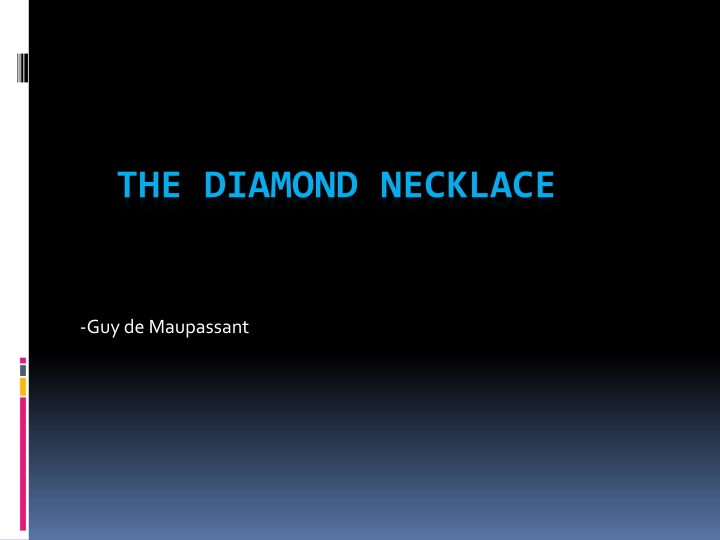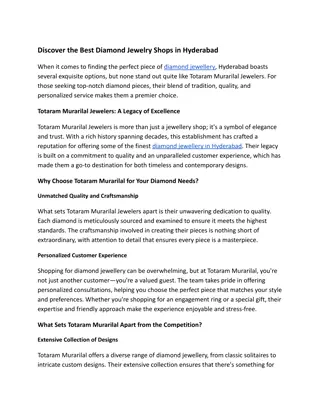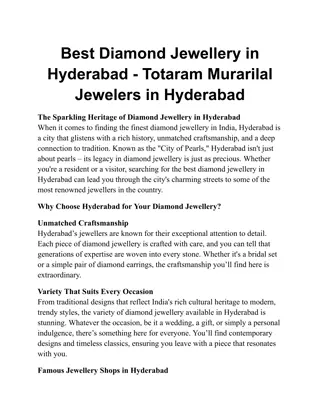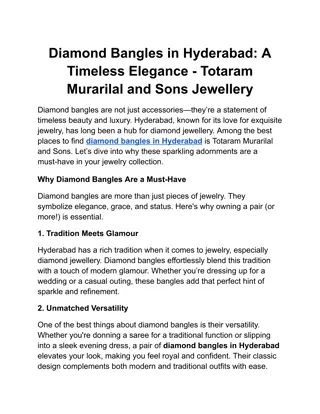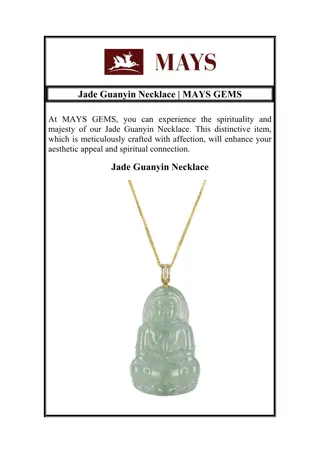The Diamond Necklace by Guy de Maupassant Summary
Mathilde, born into a low-class family, marries a clerk and is unhappy with her modest life. When invited to a ball, she borrows a diamond necklace from a friend and loses it. To replace it, the couple goes into debt and endures hardship until the truth unravels without suspicion.
Download Presentation

Please find below an Image/Link to download the presentation.
The content on the website is provided AS IS for your information and personal use only. It may not be sold, licensed, or shared on other websites without obtaining consent from the author.If you encounter any issues during the download, it is possible that the publisher has removed the file from their server.
You are allowed to download the files provided on this website for personal or commercial use, subject to the condition that they are used lawfully. All files are the property of their respective owners.
The content on the website is provided AS IS for your information and personal use only. It may not be sold, licensed, or shared on other websites without obtaining consent from the author.
E N D
Presentation Transcript
THE DIAMOND NECKLACE -Guy de Maupassant
French writer Guy de Maupassant is famous for his short stories, which paint a fascinating picture of French life in the 19th century. He was prolific, publishing over 300 short stories and six novels, but died at a young age after ongoing struggles with both physical and mental health.
SUMMARY Mathilde is born to a low-class family; with no money for a dowry, she is married to Monsieur Loisel, a clerk from the Board of Education. Mathilde now Madame Loisel had always felt like she should have been upper class, and is unhappy in her married life. she hates their home, their food, and her lack of fine clothing and jewelry. One evening, her husband excitedly presents her with an invitation to attend an event at the Minister of Public Instruction s home.
To the surprise of M. Loisel, Mme. Loisel throws the invitation down in dismay, weeping and complaining that she has nothing to wear to such an event. Her husband offers to give her the money for something suitable, but as the day of the ball approaches, she is still dismayed. When asked why, she replies that she is embarrassed to attend the ball without any jewels. Her husband suggests that she ask to borrow some jewels from her rich friend, Madame Forestier. She agrees and goes to see her friend the next day, greedily choosing one of Madame Forestier s finest necklaces.
At the ball, Madame Loisel is a hit: elegant, joyful, and desired for waltzes. She and M. Loisel return home at nearly 4 o clock in the morning, and only when they arrive home does Mme. Loisel realize she lost the necklace. After a week with no news, M. Loisel proclaims that they must replace it, and the couple finds a replacement for 36,000 francs.
Loisel has 18,000 francs from his fathers will and borrows the remaining sum, bit-by-bit and making ruinous promises . along the way. After all this, Madame Loisel is able to return the newly bought necklace in the original s case, apparently rousing no suspicion.
To pay off the debt, both Monsieur and Madame Loisel must work tirelessly. After ten years, they are finally able to pay off all of their debts. One day, while taking a walk, Madame Loisel runs into Madame Forestier. She approaches her old friend, but Mme. Forestier almost doesn t recognize her.
In sudden emotion, Madame Loisel reveals her entire story of losing the necklace, replacing it, and working off the cost of the replacement ever since. In response, Madame Forestier replies that the original necklace contained not actual diamonds but rather fake diamonds, meaning the original necklace cost no more than 500 francs.
CRITICAL ANALYSIS Mathilde Loisel A beautiful woman who yearns for a life of luxery and wealth. When she is invited to a fancy party, she borrows a necklace from her wealthy friend Madame Forestier because she refuses to go to the party without expensive jewels and a beautiful gown. After a night of happiness, during which she immerses herself in the life of glamour that she believes she deserves, she spends the next ten years paying for her fleeting happiness as a result of losing the borrowed necklace.
Monsieur Loisel: Mathilde's devoted husband who is content with his humble lifestyle. He finds it completely incomprehensible that Mathilde does not accept their lifestyle; nonetheless, he appeases her desires for glamor and fun because he wishes for her to be happy.
Madame Forestier Mathilde's wealthy friend. Every time Mathilde visits her, Mathilde is consumed with jealousy. Madame Forestier lends Mathilde the necklace for the party; eventually, we discover that the necklace contained fake diamonds.
Theme Gender Gender plays a large role in this short story, as it did in 19th-century French society. In the story, Madame Loisel is a woman dissatisfied with her social class, but, as a woman, she can do nothing to change this position besides marrying someone of higher class. On this topic, Maupassant writes, "women belong to no caste, no race; their grace, their beauty, and their charm serving them in the place of birth and family."
Social Class: Works of Literary Realism often focus on the theme of social class, and "The Necklace" is certainly an example of this. Mme. Loisel's greatest concern is her own social class, especially the way she is perceived in society in virtue of her appearance and attire. It is her focus on social class that causes her to borrow a necklace to wear to a party to which she and her husband have been invited; in an ironic twist, this very necklace results in them becoming even lower in social class when they lose it and must work to pay for a replacement.
Beauty: This short story questions whether beauty is inherent or rather imbued in something in virtue of its social value. One example of this is Mme. Loisel's reaction when she sees Mme. Forestier's necklace: even though it is made of fake jewels, her belief that it is made of real diamonds causes her to quake from its beauty.
Women generally did not hold jobs and thus had little control over their social status besides through marriage. Thus the beginning of "The Necklace" depicts an unhappy marriage largely because Mme. Loisel yearns for the lavish life that her husband cannot provide her. However, once her actions have driven both herself and her husband to a lower social class and years of burdensome work, their marriage seems to improve and the couple is able to cooperate.
Happiness One surprisingly uplifting theme of this short story is the fact that it seems happiness comes from being content with whatever one has. When Mme. Loisel has a middling social status but desires to be higher in society, she spends her days yearning and weeping. However, once she and her husband have been driven to toil for ten years, she seems content and sometimes nostalgic, happier than she was before. In fact, when she tells Mme. Forestier of the work she has done for ten years to pay off the replacement necklace, Maupassant writes that she "smiled with a proud and simple joy"(p.38).
The Necklace Symbols, Allegory and Motifs The Necklace (Symbol) In Maupassant's "The Necklace," the necklace itself represents the surface-level nature of social class. The necklace is made of fake jewels, but Mme. Loisel perceives it as beautiful because she believes it to be real. Similarly, Mme. Loisel is perceived as beautiful at the party because of the confidence and status that dressing like an upper-class person gives her.
Clothing (Motif) Maupassant often mentions the clothing of people as a representation of their social status. Mme. Loisel is described early in the story as "not being able to adorn herself and yearns after having "two great footmen in short trousers . Her greatest fear when attending the party is that she will not have an appropriate dress and jewelry; even at the party, she is embarrassed by her cheap wrap. Significantly, once brought to a low social class by the necessity of paying off the replacement necklace, Mme. Loisel is described as being "clothed like a woman of the people...her hair badly dressed, her skirts awry"(p.36-7).
